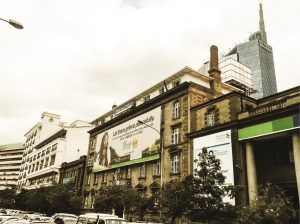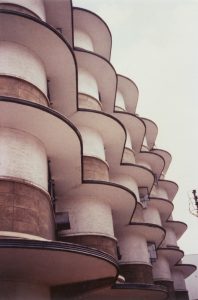The development of architectural styles in Nairobi can be traced to the arrival of the railway line on the vast plains through which flowed nrobi (stream of cold water), in the Maa language. The railway builders chose this area as an ideal resting destination while awaiting ascent of the steep Limuru escarpments (Hill 1976). According to Van Zwannenburg and King (1975), the choice of Nairobi was further enhanced through its functioning as a trading centre for Kikuyu and Maasai women prior to the coming of the railway. The present site of Nairobi was selected as a stores depot, shunting yard (place where trains are shifted from one track to another), and camping ground for the thousands of Indian labourers (also British colonials, who came to Kenya seeking work) employed by the British to work on the line. Arthur Church was commissioned, there- fore, to prepare a town layout for the railway depot in 1898 (Hill 1976).
This plan, the first official one for Nairobi, had two main streets, Victoria Street (today Tom Mboya Street) and Station Street. It also had ten ave- nues, staff quarters and an Indian commercial area (Hill 1976). The rail- head reached Nairobi on 30th May 1899 (Smart 1950) and found a small depot active with trade and commerce. In the same year the administra- tive government was also set up (Pavitt 2008). This duality as a meeting and administrative point established Nairobi as a key town along the railway line. In 1899 Engineer Sir George Whitehouse remarked that ‘Nairobi itself will in the course of the next two years become a large and flourishing place and already there are many applications for sites for hotels, shops and house’ (cited in Tiwari 1981). In 1907, Nairobi was made the capital of Kenya.
In 1920, Nairobi’s size was 25 km2, in 1927 it was 90 km2 and by 1995 the area had grown to 684 km2 (UN 1995). As Nairobi grew, so did its commercial and administrative status. As areas such as Bazaar Street (today Biashara Street) came into being, main business streets like Delamere Street (today Kenyatta Avenue) and Government Road (today Moi Avenue) also emerged as important shopping areas. Thus, a majority of the city’s old buildings are found on these streets. According to Smart (1950), the early phase of Nairobi’s development was largely characterized by the emergence of corrugated iron sheet structures which were to change from 1906 as dressed stone started appearing with the transformation of the Bank of India into the first stone building.
As the settlers established themselves, eclectic Victorian-period buildings characterized by massive masonry and attractive façades started dotting the railway town in both folk and academic forms (Wahome et al. 2013).
The British colonialists brought along their culture and customs, which influenced the existing local cultures. Arguably, the most significant influences introduced by the colonialists were their system of gov- ernment and their styles of architecture. The impact was felt in both public and private architecture in and around the town centre in form of institutional, commercial and residential buildings.
Undoubtedly, the European style influenced the architectural development of the city in multiple ways. It is, however, noteworthy that Nairobi is a multi-racial city comprising a predominantly African population with European and other racial groups. Consequently, its development has been influenced by these various cultures as well, and their legacies are visible in the rich and diverse architectural heritage that remains until today.
Historic architectural morphology
To appreciate the significance of historic buildings in Nairobi, an under- standing of the influences on appearance, shape and form is important. Attributes that reflect a time period of history carry with them evidence of the thinking of the builders. Nairobi’s historic buildings have borrowed from diverse influences and merged with local peculiarities to give rise to buildings that have homogenous characteristics.
Building materials
A survey of the historic buildings in Nairobi indicates that these buildings give the city an important, distinguishing character. As morphology is concerned with factors that govern and influence form, it is noteworthy that European settlers predominantly used locally available materials in their construction. Blue granite stone was easily avail- able in and around Nairobi; it was durable and thus widely used inbuilding. Most historic buildings still retain their rustic facades of blue granite stone, but some have suffered from haphazard application of paint and other renders.
Another material of notable usage was Nairobi claystone. It was used for important buildings such as All Saints Cathedral. Although easy to dress, use of claystone was somewhat replaced by concrete blocks and ferro-concrete construction due to several factors including location of its thin outcrops on steep valley slopes (which made it uneconomical to quarry), its dull colour, and its difficulty to extract in large sound blocks. Claystone, however, remained popular in construction of residential buildings.
As of the late 1940s, sand was harvested in Athi River, Konza, Ulu, and Kajiado areas and shipped by rail to Nairobi. No lime was being produced in Nairobi, although limestone deposits in Athi River existed. Lime was obtained from Kenya Marble Quarries near Kajiado, Mombasa and Homa Bay.
Comparatively low quantities of bricks and tiles were made. This was due to their production being dependent on rainfall for water supply and difficulties in obtaining sufficient labour and fuel. Roofing tiles were produced locally, though tile production experienced similar challenges to brick production. Cement roofing tiles were also being manufactured in Nairobi as of the late 1940s.
Some materials were imported, however, such as Mangalore tiles (of hard, lateritic red clay originating in Mangalore, India) used for roof- ing. Overall, before the 1950s no cement was made from raw materi- als in Kenya (White etal. 1948). Doors and windows were framed from hardwood timber which was harvested from the indigenous forests. Grilles and other metallic motifs were curved from wrought iron.
Foreign building styles and their attributes
It is noteworthy that while some architectural styles are universally recognized, there is sometimes variation among scholars and historians on their categorization, naming of styles and periods of popularity. The historic buildings in Nairobi have borrowed a lot of their building character from foreign influences, mainly colonial-imported architecture. These influences are visible individually or in combinations in various buildings. Some of the architectural styles and their characteristics are described as follows:
A) European influences
(i) Classical revival style: Classical revival is based on the architecture of Ancient Greece and Rome (City of Chicago (COC) 1995).
It was widespread in colonial Nairobi; it is expressed largely in public building architecture. It was meant to be a symbol of expression of imperial authority (Wahome et al. 2013) in the colony. Common characteristics include sym- metrical façades, towers or other projecting building elements, classical ornaments including columns, cornices and triangular pediments, roofline balustrades, and use of a wide variety of materials, including bricks, stone, terra cotta and wood. Some important examples in Nairobi include Railway Headquarters, Law Courts and City Hall.
(ii) Renaissance revival style: The churches and palaces of Renaissance Italy were the inspiration for this revival style (COC1995). It emphasized the rebirth and development of distinctive ancient Greek and Roman material culture. Common characteristics include symmetry, rustication, quoining, profusion of triangular and round-arched pediments, cornices and lintels, proportion, geometry and regularityofpartsaswas particular to classical Roman architecture and round-arched windows and arcades (that is, covered walkways or porches, formed by rows of arches rested on columns). In Nairobi, it manifested itself in buildings like the current Panafric House and the Westminster buildings along Kenyatta Avenue, where clean dressed local stones adorn their facades.

(iv) Georgian architectural style: It is named after eighteenth- and nineteenth-century British monarchs. Georgian designs usually lay within the classical orders of architecture and employed a decorative vocabulary derived from Ancient Rome or Greece (COC 1995). Late Georgian architecture’s common characteristics include proportion and balance, use of simple mathematical ratios, symmet- rical facades often with side porches, use of brick, stone or wooden walls, entrances decorated with sidelights, transoms, ornamental columns and pediments. The Old Provincial Commissioner’s Office building and Kipandc House along Kenyatta Avenue are good examples of this eclectic style.
(v) Tudor revival style: The Tudor style was an attempt to create architecture with a traditional, picturesque appearance. It is based on English domestic architecture from the 1500s and 1600s (COC 1995). Common characteristics include: steeply pitched roofs – often with front facing gable or multiple gables, decorative timbered wall surfaces, decorative front or side chimneys, diamond-shaped casement windows, use of stucco, masonry or masonry-veneered construction, often with ornamental stonework or brickwork and irregular massing. This architecture resonated mainly in residential buildings, although a few commercial buildings were constructed using it, for instance Norfolk Hotel along Harry Thuku Road.

B) Asian influences
The character of Nairobi in the early years was a combination of two disparate elements: the railway area and the congested Indian Bazaar.
After World War I, European settlers gained more influence in colonial administration and one instrument they employed to propagate their presence was town planning, especially zoning. This meant that various locations were designated as European, Indian and African residential areas. The areas allocated to Indians included the Indian Bazaar, which combined residential and commercial activities in a building typology influenced by practicality and typologies found in India. This comprised commercial activities on the ground floor of the building with residential quarters on the upper floor or a commercial sec- tion towards the front of the building with a residential section towards the rear, often housing lodgers (White et al. 1948). Use of materials was also distinctive, with many structures being initially constructed from corrugated iron sheets (typically for roofing, but sometimes also for walling), either exclusively or in combination with other more permanent materials such as brick and stone. Away from the bazaar area, Indians were provided with bungalows in Pangani in 1927 that lacked basic functional elements like sitting rooms or courtyards (Salvadori 1996).
Therefore, the Indian non-registered architects took advan- tage of these shortcomings to modify the buildings. Elsewhere, they also built religious buildings such as Singh Sabha Sikh Temple. The ease of execution and functionality of these Indian styles led to other architects borrowing and replicating them in other structures like Sheria House (Figure 5.7) and Parliament Buildings. Elsewhere, they also built religious buildings such as Singh Sabha Sikh Temple.
Status of historic buildings
Clearly, Nairobi’s historic buildings have considerable architectural merit that warrants their maintenance. The walls of most buildings are gener- ally in good condition; surface erosion has been moderate, carved orna- mental details are still relatively crisp in most locations. However, there is noticeable vertical and diagonal cracks and discolouration in some build- ings where neglect has crept in. Due to weather conditions and adverse human use, some buildings require extensive intervention to restore them to their original appearance, for instance, the IBEA building along Moi Avenue. Other buildings have been allowed to deteriorate to the ‘point of no return’ and their restoration would prove both technically difficult and cosdy, for instance, the ‘1918’ building along Ronald Ngala Street. The preservation and significance of these buildings is being undermined by:
- Lack of proper maintenance
- Total destruction of historically and/or architecturally significant buildings
- Change of buildings’ character due to inappropriate additions and alterations
- Pollution





